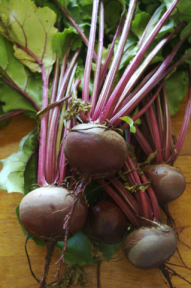Beetroot
 Common Names: Beet, beetroot, table beet, garden beet, red beet, dinner beet or golden beet
Common Names: Beet, beetroot, table beet, garden beet, red beet, dinner beet or golden beet
Scientific Name: Beta vulgaris
Climate: Temperate
Plant description: It is an herbaceous biennial (infrequently perennial) which is typically grown today as an annual. It can reach the height of 2 m. Long, dark-green, ovate to wedge-shaped, long-petioled, basal leaves appear in rosettes with smaller, alternate, second-year stem leaves. Roots are deep purple-red, golden yellow or red/white striped; they are thick, or tuberculous and usually swollen roots.1 Flowers (usually greenish, but sometimes with red or purple tinges) bloom in dense spikes only in the second year, which means the flowers are typically not seen when plants are grown and harvested for their beets and/or leaves as one-year annuals.2
Beets were domesticated in the ancient Middle East, primarily for their greens.3
Cultivation: Full sun. Prefers cool weather. Beets adapt to most soil types, with an exception of the one that is too alkaline or too acid soil. It needs to be light, moist and fertile. Thus adding compost or worm humus will be beneficial to the growth of the root. It is possible to grow beetroot in raised beds but it is important to make sure they don’t dry out. Beets can withstand freezing temperatures, but plants exposed to 2 to 3 weeks of cold weather (below 10°C) may go to seed early, especially after the first leaves have developed.
Sow the seeds in early spring or late fall. Beet seed in reality is a protective capsule enclosing two or three true seeds. This means that for each seed capsule planted it will be necessary to snip off at least one seedling with scissors or a sharp knife, to give the remaining seedling the space to grow on. Before planting dig down deeply at least 25 cm to promote good root development. Sow seeds 3 cm apart. Thin rows as plants develop and apply 10 to 20 cm of mulch to help maintain soil moisture and limit weeds. Promote rapid growth by feeding every three weeks with a balanced organic fertilizer and if possible seaweed extract. Beets shouldn’t need any additional watering unless the soil looks like it will dry out completely.
Throughout the growing season, sprinkle thin layers of grass clippings around beets. These clippings will add small amounts of additional nitrogen to the soil, which the beets need. It also helps to retain moisture and keep weeds down.
Begin harvesting beets when roots reach 3 to 7 cm across (typically 55 to 70 days after sowing seeds). Do not allow roots to grow larger than 8 cm or they will be tough and woody. Greens are ready to harvest 30-45 days after planting.
 Uses: Beetroot and leaves are eaten as vegetables: raw, in soups, salads, main dishes. They are boiled, roasted, or raw. Beetroots are converted in pickles or are fermented and used as a powerful probiotic. Beetroot can also be used to make wine.4
Uses: Beetroot and leaves are eaten as vegetables: raw, in soups, salads, main dishes. They are boiled, roasted, or raw. Beetroots are converted in pickles or are fermented and used as a powerful probiotic. Beetroot can also be used to make wine.4
Beets are high in valuable vitamins and minerals. They are used in the treatment of liver disease and fatty liver. They are also used to help lower levels of triglycerides in the blood, lower blood pressure, improve athletic performance, and reduce muscle soreness.
Betanin, obtained from the roots, is used industrially as red food colorant, to improve the color and flavor of tomato paste, sauces, desserts, jams and jellies, and ice cream.5
Pests and diseases: No serious insect or disease problems. Beets may suffer from fungal leaf spots, downy mildew, powdery mildew and root rots. Watch for leaf miners, flea beetles, leafhoppers, aphids and caterpillars.
References:
-
It is widest near the surface of the soil and tapers to a point as it grows deeper into the ground. Small side roots grow out from the tap root which do not become swollen.
- http://www.missouribotanicalgarden.org/PlantFinder/PlantFinderDetails.aspx?kempercode=a668
- https://en.wikipedia.org/wiki/Beetroot
- Making Wild Wines & Meads; Pattie Vargas & Rich Gulling; page 73
- Grubben, G.J.H. & Denton, O.A. (2004) Plant Resources of Tropical Africa 2. Vegetables. PROTA Foundation, Wageningen; Backhuys, Leiden; CTA, Wageningen.
En español: Betabel
